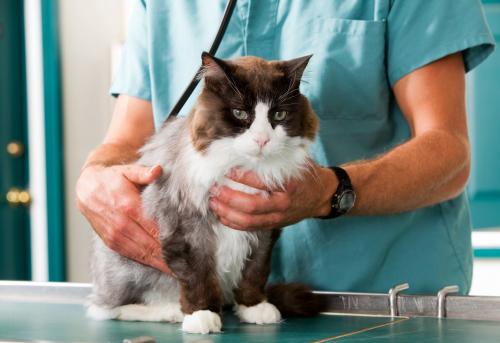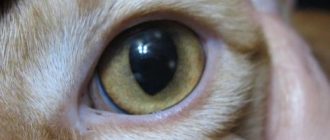Emergencies occur suddenly and without warning. Have a basic understanding of basic veterinary emergency situations and be able to provide first aid to cats – important for all pet owners animals.

Some PEs are obvious, while others may initially be invisible. Of course no one can be prepared for everyone emergency situations, but there are a few easy steps to follow by which, you can determine by clinical signs that with something is wrong with your cat. Then, you can give her the first help, and possibly save her life!
What to do in case of emergency?
Contents
- Keep calm and evaluate the situation for any additional threats to you or to your pet.
- Keep the cat as calm as possible and bring it down movements to a minimum, especially if she has a possible injury, broken limbs, or any other neurological symptoms.
- Contact your veterinarian for information about the situation. and get first aid instructions.
- To move a cat safely into transport, use suitable container or carrying for cats (best of all, remove the lid of the container to prevent accidentally injuring the cat through small door or hole). Cover the cat with a towel or a blanket. Also use a fabric lining. (towels) to stabilize the neck and spine animal.
- Take the cat to the clinic as quickly as possible, but follow reasonable caution!
Are there any tips on holding and handling injured by a cat?
Most animals in an emergency will disoriented and may panic. Severe stress and pet panic can make a pet friendly aggressive. Although most alarmed cats respond well on a soothing voice and stroking the head and shoulders, be careful when approaching and touching the injured animal.
- Putting a muzzle on a cat can be a difficult task, as the shape of the muzzle of cats varies greatly. There are special muzzles designed for cats, but they rarely fit and Uncomfortable to dress, especially if an emergency has occurred. For some cats, a makeshift muzzle from a couple is suitable tights wound around the head and tied with a piece of rope. Such a muzzle will prevent any possible bites. If option c muzzle does not suit you, then use a simple towel, to provide at least some degree of protection.
- You can wrap the body of a scared or uncontrollable cat bag or towel. Do not compress the trachea or airways. If possible, then leave the cat’s head free, but if the cat is very aggressive, it will be safer to wrap it whole. You Should NOT wrap the cat in cases where you have suspicions for fractures or spinal injuries.
- If you have a suspicion that the cat has a back injury, then immobilize it with belts or ropes. Pay particular attention to immobilization of the head and neck. For transporting a cat, best of all use a big box.
What emergencies can happen to a cat?
There are many emergencies that can happen to a cat, ranging from hitting a car and ending with acute internal problems such as bowel blockage or Bladder. Below you will find a list of the most common and serious problems and injuries that require emergency veterinary help, as well as descriptions of common clinical signs and first assistance needed in these situations.
Anaphylactic shock is severe an allergic reaction characterized by sudden inflammation and severe breathing difficulties. First clinical symptoms often swelling around the muzzle, the appearance of blisters or urticaria on the skin, vomiting or diarrhea, anxiety. These symptoms can progress rapidly and make breathing very difficult. There are many reasons for the development of anaphylaxis, ranging from bites insects, and ending with an allergy to certain foods. You must contact your veterinarian immediately if you think your pet may suffer from anaphylaxis.
Car injuries (injuries after an accident) – It’s important to make sure your cat’s airway is clear, but not put your hand in her mouth if she is conscious. Tax the wound with suitable available material. Treat your cat with caution, supporting her body as gently as possible. Take her to the clinic in a basket or box.
Bites and wounds after a fight – clean wounds with using warm water and cover them with clean material to prevent further pollution and infection. Then contact for veterinary help.
Bleeding (hemorrhage) – If a wound is on a limb, then apply a tourniquet above the wound enough tight to significantly reduce blood flow. Loosen the harness approximately every 20 minutes. Put a towel on the wound or another material that will absorb blood. Dress the wound strong enough or just apply direct pressure and contact your veterinarian.
Shortness of breath – if your cat has difficulty breathing, especially if she breathes with open by mouth, then you need to contact your veterinarian immediately. If the cat doesn’t breathe, then she needs to have a heart massage and artificial respiration.
Burns – initially, you may not notice these injuries, as they are often hidden under the coat. But then when cats suddenly drop their hair and the skin begins to peel off, they become apparent. The most common cause of burns Cats is a hot wood stove or minicamine. Chill burnt area with cool running water and cover it with wet with a towel. It will also help remove caustic substances (acids or alkalis) if they cause a burn. In case of burns, caustic substances, keep it under running water for 15 minutes. IN during this time contact as soon as possible by the veterinarian.
Cramps and seizures – a series of strong uncontrolled cramping. Most seizures last no more than two minutes. If the attack lasts more than five minutes or if there is a sequence of several seizures, then your cat needs urgent veterinary care to prevent irreversible damage. Do not put your hand in your mouth during an attack. to your pet. Cats do not swallow their tongue. Follow the steps precautions and protect yourself, and also prevent the cat from possible fall. After your cat recovers, keep calm and speak in a soothing voice, easily stroking her. The cat must be shown to the veterinarian to determine the cause of the attacks.
Diarrhea or vomiting – continuous or recurring vomiting or diarrhea (diarrhea), with or without blood, may be a sign of poisoning, intestinal obstruction, or gastrointestinal infection. Dehydration is Severe danger to cats. Contact your veterinarian if you notice in blood stool, or if diarrhea or vomiting persists for longer 12 hours, or if the animal becomes less sensitive and weak. Do not make the cat eat or drink – you may accidentally worsen her condition. Never use drugs on cats. for people if this is not agreed with the veterinarian. Acetaminophen and acetylsalicylic acid (aspirin) are toxic to cats.
Eye Injury – Many eye injuries can lead to blindness or even loss, if not properly to heal. If the cornea is scratched or pierced, it will be extremely painful. Do not let the cat continue rub your eyes, causing further damage. Sudden blindness or loss of vision (the cat will start to bump into objects or will have difficulty jumping on furniture and you may notice that her pupils will be dilated) may be symptoms glaucoma. If the cat develops these symptoms, or it discharge from the eyes or squinting appeared then immediately seek veterinary care.
Heat stroke – symptoms of heat stroke are shortness of breath, lethargy and malaise, these symptoms can quickly progress to fainting and death. In most heat stroke occurs due to unventilated carry in a car. As a first aid, refrigerate immediately your cat’s body temperature by placing it in a cold bath water. When you are ready, take the cat to as soon as possible veterinary clinic wrapping it in a cool wet towel.
Hemorrhagic gastroenteritis is a condition characterized by severe diarrhea (diarrhea) with blood, with or without vomiting Often cats become very weak. Contact immediately to the vet. This is a serious disease, especially in cats.
Injury – some injuries, depending on type and degree of injury, require urgent medical attention. If you suspect your cat has a broken bone, put it in carry or carry the box and minimize its movement. Any penetrating wound in the chest or abdomen and almost any injury, associated with the eyes should be considered extreme situation requiring emergency medical care. Head injuries and breathing problems should also regarded as emergency situations.
Poisoning – the main causes of poisoning cats include eating mice that have been killed by poison, eating baits or drinking ethylene glycol (antifreeze). Typical symptoms poisoning are vomiting, diarrhea, salivation, and skin irritation cramps. If the poisonous product is known, then look. first aid instructions, e.g. whether to call vomiting or not. You can induce vomiting with one teaspoon a three percent solution of hydrogen peroxide or a teaspoon of salt, placed (flooded) in the back of the cat’s mouth. Do not call vomiting if a cat swallows an object (plastic packaging, paper, etc.). If aggressive or toxic material is on the skin, then rinse it with water for fifteen minutes. Take a sample of the alleged poison in a container and show it to the vet.
Fainting – may occur as with cramps, so without. Fainting often happens suddenly, for example, in the case of acute heart failure or after a blow to the head. Contact your veterinarian immediately and get further instructions.
What are the symptoms of shock?
Shock has many definitions. This is a complex pathological process accompanied by a violation of a vital system organism, or the reaction of the whole organism in response to damage. is he may be caused by severe injury, hemorrhage or sudden blood loss, heart failure, or other impairment blood circulation (e.g., severe allergic reaction and heat hit). Life-threatening drop in blood pressure is the most dangerous part of shock. Without prompt assistance, shock can cause permanent damage to body cells, which, in may ultimately be fatal.
Symptoms are rapid breathing, which may be noisy, palpitations with a weak pulse, pale (possibly even white) mucous membranes (gums, eyelids), severe malaise, cold limbs and ears. The cat can be observed vomiting
And in conclusion, it is worth noting that after an emergency accident or accident, it is important that you show the cat to the vet as soon as possible, even if it seems to you that she is completely is healthy.






